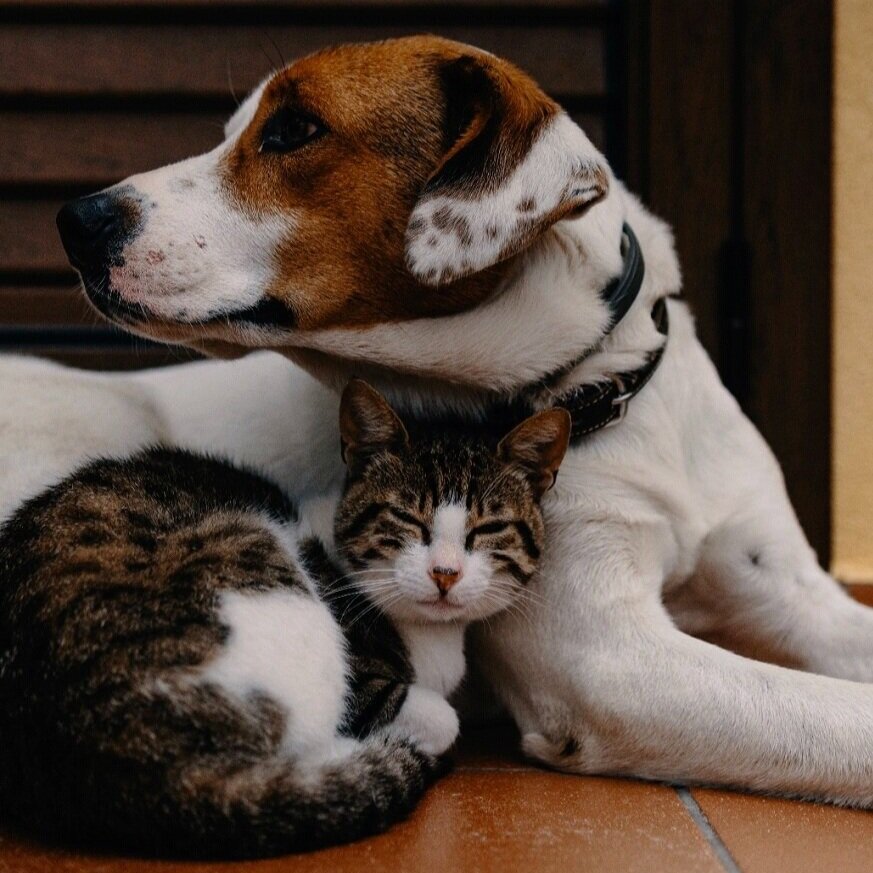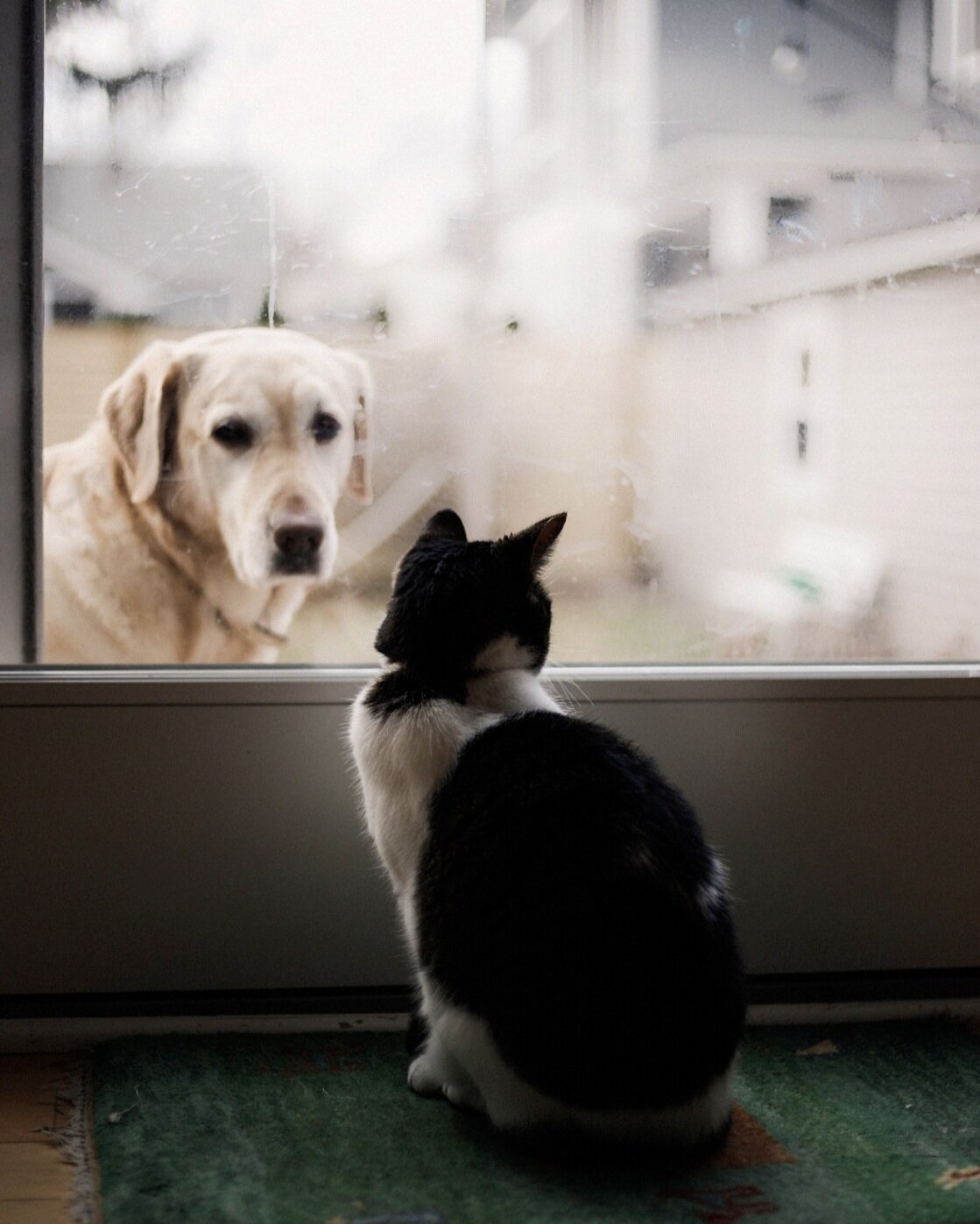Bringing Home a New Pet: Introducing Your New Cat To Your Resident Dog
This blog series will have three installments. There is a lot of information here, but please don’t get overwhelmed! With a little time and planning, you will soon be well on your way to safely welcoming your new pet into your home and successfully integrating them with other furry family members.
Wouldn’t it be great if your new cat and dog snuggled together? Don’t get your hopes up too high, that kind of special relationship and bond is not common between cats and dogs. But there is hope! Depending on the personalities of each pet in your home and whether you set each pet up for success when introducing them, all the pets in your home cohabitating peacefully is possible!
TAKE IT SLOW
All steps in the introduction process should be taken gradually, making sure each pet is comfortable along the way. Just as you took your time to slowly acclimate your cat to their new environment, introductions to your dog should be centered around slow desensitization. There are some dogs that can never live safely with cats. Understanding your dog’s prey drive and their level of obedience will help you determine whether peaceful cohabitation is possible in your home.
Just like each cat and dog has their own personality and behaviors, each introduction between pets is unique. Pay close attention to both pets’ body language and make the introduction in a controlled environment. Avoid creating a situation where your cat will run away and potentially excite your dog’s instinct to chase. Consider keeping your dog on a leash during the introduction process.
BODY LANGUAGE
Look closely for physical cues by reading your dog’s and cat’s body language in each new situation and environment.
A dog that is intensely staring at a cat with a stiff body is a clear sign that they are too interested in the cat and a safe introduction can’t yet take place. How else will you know your dog is not ready to meet your new cat? Dogs show nervousness through tight lips, lip licking, yawning, heavy open mouth breathing, pinned back ears, inappropriate self-grooming, looking away, tucking their tail between their legs, whining, whimpering, full body shakes and more.
Dogs show overexcitement through intense staring, “frozen” body stances, raised hackles (the fur on the back of their neck and along their spine is raised), drooling if they don’t normally drool, growling, lip “curling” and baring their teeth, barking and pacing or circling.
A cat shows signs of distress through large, dilated pupils, pinning their ears back or out, making “airplane ears”, fluffing or lowering their tail, lowering their head and/or their body, growling, hissing, spitting and swatting. A scared cat might try to make their body look very small, or they may try to make themselves look as large as possible with fluffed fur, an arched back and standing on their toes.
A dog or cat displaying these types of behavior is clearly not ready to meet a new pet.
Conversely, if your pets have loose, flowing and relaxed body language they are showing clear signs of being cool, calm and collected. This body language signals that a safe introduction can take place.
WHAT’S THAT SMELL?
When your dog is confined to a separate or outdoor area, allow your cat to investigate and explore areas where your dog spends time like around their bed, the couch, their feeding area, etc. After your cat has had time to sniff things out and leave their scent behind, return your cat to their safe, confined room. Let your dog back in to investigate the new smells in his area.
DO YOU SEE WHAT I SEE?
Put a baby gate up at the doorway of your cat’s safe room. Leave the door closed, with the baby gate up at first. Crack open the door a bit, so each pet can see the other and then reward each pet separately with treats and attention if they don’t cause a ruckus. You are creating a positive association for both pets by rewarding good behavior, which is the key to successful training. Practice these brief visual introductions throughout the next couple of days and continue to allow the cat to explore the dog’s domain when he is separated and confined away from the area.
Once your dog has mastered good behavior during continued, brief visual introductions to their new feline friend, it’s time to start redirecting the dog’s attention to a toy, a bone, or something else while the door is open (but remember to keep the baby gate in place!). Continue spending time redirecting your dog’s attention. If your dog is responding quickly to your command and ignoring the cat, it’s time to progress to the next step.
Leave the door to the cat’s safe room open, keeping the baby gate in place. Pay attention to both the cat and dog and if the dog is behaving well, keep the door open for short periods of time, extending these sessions slightly longer with each successful interaction. Remember to keep rewarding both pets for their good behavior with treats or attention!
The goal is for your dog to lose interest in your new cat while they are near each other. It is a good idea to keep the baby gate up while you are home for the first several weeks and sometimes months, depending on their progress. Remember to keep your pets’ safety a priority and always separate them when you are not home. Dogs can easily harm a cat and some cats will protect themselves by scratching and harming a dog in pursuit. Some pets will never be able to be left alone together, while some will be fine after a successful desensitization period.
Some dogs will end up loving their feline brothers and sisters – maybe even more than cats would like!
SIBLING RIVALRY
If your pets still aren’t getting along, it might be time to consult with your vet, or a behavioral consultant. If you take your time (and with a little bit of luck), your new addition will integrate smoothly and will join the family routine in no time at all. Don’t resort to punishment when training your pets to coexist peacefully, as this type of training often results in the opposite effect: a worsening situation.
Remember whenever changing your pets’ lifestyle, environment, or family makeup that the key component is taking your time and monitoring them carefully. If you are adding a new pet this year, keep your home environment calm and happy by giving your resident pets plenty of attention. Work on their schedule, not yours, and take your cues from their behavior.
By: Anna Bowers



